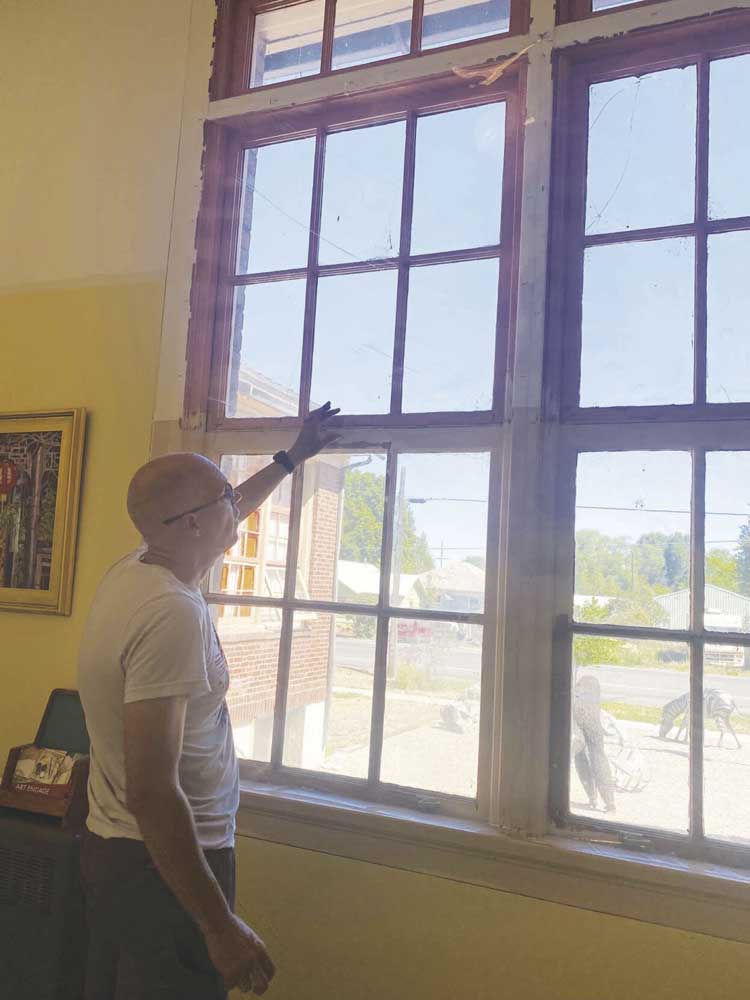Project to convert Baker City schoolhouse into venue gets boost
Published 3:04 pm Monday, July 5, 2021

- Brian Vegter shows some of the windows in the Churchill School that he and his wife, Corrine, plan to repair with help from a state historic preservation grant
Turning a 95-year-old schoolhouse into a modern venue for music, art and hospitality is no easy task, especially when every part of the building needs renovation.
That’s why it meant so much for Brian and Corrine Vegter, the Baker City couple who bought Churchill School in May 2018, to receive a Preserving Oregon grant from the Oregon Parks and Recreation Department.
The $4,607 grant, which the Vegters will match with $4,645, will help the couple as they continue work on the project .
“Corrine and I both look at what we’re doing as preserving a piece of shared history for the entire community,” Brian Vegter said. “What we do with the space is provide opportunities for community gatherings, and we see ourselves as a key part of the arts and culture community for the county and Eastern Oregon in general.”
The state grant program is for historic property preservation and archaeology projects across the state. Brian Vegter said he had applied for the grant four times, but this is the first year he has been successful.
The application process is intense, he said, with no communication between the applicant and the reviewers during the judgment-making period. The application has to explain in detail everything the grant money would be used for, and Vegter believes he didn’t receive the grant the first three times because of miscommunication in the application process.
The Vegters plan to use the money to help repair roofing and windows, several of which have cracks in the glass panes. It is important that the windows are exact replicas of what they were in 1926 when Churchill opened.
The window sills need paint, and some require wood filler. Many windows either don’t open or are hard to open after nearly a century of use. Fixing the windows will also make Churchill more energy efficient — the majority of the building rarely dips below 80 degrees on hot days.
“For preservation standards, in order to maintain your status on the historic register, everything on the exterior of the building needs to basically remain the same as it was when it was built,” Vegter said.
Churchill was registered on the National Register of Historic Places in 2008. One of the criteria for getting on the register is that the building must have some historical significance, and Churchill is one of two remaining buildings designed by Charles Lee Miller, who built over 400 projects throughout his career. It’s the only building he designed that is still standing in Baker County.
The building, on Broadway Street between 16th and 17th streets, operated as a school from 1926 until 2002, when the Baker School District closed Churchill. The district sold the building to Jim and Pam Van Duyn in 2006.
Vegter said the school didn’t have electricity for much of the following years, during which it was vandalized multiple times.
When the Vegters bought Churchill in 2018, they needed three months to get basic amenities installed, including electricity, a working toilet and running water in one sink.
The couple sold their Baker City home and liquidated their savings to pay for renovations at Churchill. They lived in a trailer until they got electricity in the school and moved in immediately after they had enough utilities to do so. They worked from dawn till dusk so they could open as soon as possible, as their cash was disappearing fast.
“We had a dollar and we had a dream, and this was a project that we thought we could undertake,” Vegter said. “There’s lots of things that, if we had that to do again, we would totally do differently. But at the same time, we never regretted doing this.”
Many volunteers, including local and out-of-state residents, have helped the Vegters with every project for the building. However, Vegter said that the more volunteer hours Churchill has, the less funding they get from the state, so it was a hard balancing act to decide which projects need state funding and which ones they can accomplish with volunteer work.
Churchill serves as an integrative space for artists to create and sell their pieces, musicians to perform and bikers and skiers to rest while they’re in town. The Airbnb space stands in stark contrast to the rest of the building with its modern interior and remote control-operated blinds, which cost $1,000 each.
While fixing the roofing and windows with the state grant is a one-time project, there are other grants the Vegters plan to apply for in the future. There’s a lot of tuckpointing that needs to be done, which has to do with color matching the mortar in brickwork, that Vegter plans to do when he has the money for it. He hopes to be able to hire somebody to do this kind of work some day, but at the same time, he really enjoys doing these projects himself.
Fortunately, the Vegters have made connections with people who care about the building as much as they do and have helped fund various projects out of pocket. Charlie Ernst, who the Vegters met at a Cycle Oregon event, learned about the project and gave them the money to fix part of the roof, turning an $80,000 project into a $12,000 one.
“Communities rally around preservation in general,” Vegter said. “Through all the other stuff that we do in the community, we eventually developed relationships with people who are like, ‘Oh, yeah, if the Vegters say they’re gonna do something, they’re gonna do it. And we want to be part of that.’ ”






